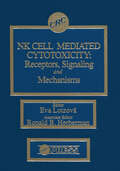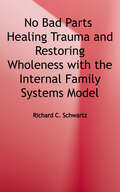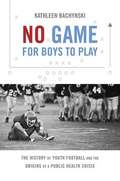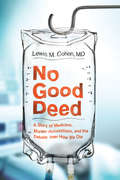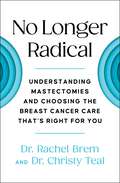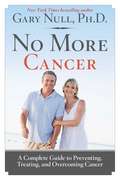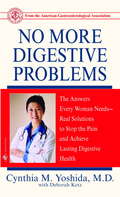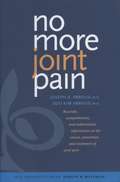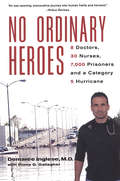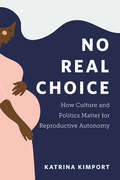- Table View
- List View
Nk Cell Mediated Cytotoxicity: Receptors, Signaling, and Mechanisms
by Eva LotzovaThis volume provides a state-of-the-art survey of developments in the field of NK cell-cancer cell interactions, activation, and oncolytic signaling. Specific topics discussed include NK cell receptors and adhesion molecules, signal transduction and activation, and mechanisms of cytotoxicity. The book will be an excellent learning tool and reference resource for scientists, clinicians, and students.
No Apparent Distress: A Doctors Coming-of-age On The Front Lines Of American Medicine
by Rachel PearsonA brutally frank memoir about doctors and patients in a health care system that puts the poor at risk. No Apparent Distress begins with a mistake made by a white medical student that may have hastened the death of a working-class black man who sought care in a student-run clinic. Haunted by this error, the author—herself from a working-class background—delves into the stories and politics of a medical training system in which students learn on the bodies of the poor. Part confession, part family history, No Apparent Distress is at once an indictment of American health care and a deeply moving tale of one doctor’s coming-of-age.
No Bad Parts: Healing Trauma and Restoring Wholeness with the Internal Family Systems Model
by Richard C. SchwartzDiscover an empowering new way of understanding your multifaceted mind―and healing the many parts that make you who you are. Is there just one “you”? We’ve been taught to believe we have a single identity, and to feel fear or shame when we can’t control the inner voices that don’t match the ideal of who we think we should be. Yet Dr. Richard Schwartz’s research now challenges this “mono-mind” theory. “All of us are born with many sub-minds―or parts,” says Dr. Schwartz. “These parts are not imaginary or symbolic. They are individuals who exist as an internal family within us―and the key to health and happiness is to honor, understand, and love every part.” Dr. Schwartz’s Internal Family Systems (IFS) model has been transforming psychology for decades. With No Bad Parts, you’ll learn why IFS has been so effective in areas such as trauma recovery, addiction therapy, and depression treatment―and how this new understanding of consciousness has the potential to radically change our lives. Here you’ll explore: - The IFS revolution―how honoring and communicating with our parts changes our approach to mental wellness - Overturning the cultural, scientific, and spiritual assumptions that reinforce an outdated mono-mind model - The ego, the inner critic, the saboteur―making these often-maligned parts into powerful allies - Burdens―why our parts become distorted and stuck in childhood traumas and cultural beliefs - How IFS demonstrates human goodness by revealing that there are no bad parts - The Self―discover your wise, compassionate essence of goodness that is the source of healing and harmony - Exercises for mapping your parts, accessing the Self, working with a challenging protector, identifying each part’s triggers, and more IFS is a paradigm-changing model because it gives us a powerful approach for healing ourselves, our culture, and our planet. As Dr. Schwartz teaches, “Our parts can sometimes be disruptive or harmful, but once they’re unburdened, they return to their essential goodness. When we learn to love all our parts, we can learn to love all people―and that will contribute to healing the world.”
No Comfort for the Lost
by Nancy HerrimanIn this atmospheric historical mystery series debut, a courageous nurse and a war-scarred police detective in 1860s San Francisco champion the down-trodden and fight for justice ...After serving as a nurse in the Crimea, British-born Celia Davies left her privileged family for an impulsive marriage to a handsome Irishman. Patrick brought her to San Francisco's bustling shores but then disappeared and is now presumed dead. Determined to carry on, Celia partnered with her half-Chinese cousin Barbara and her opinionated housekeeper Addie to open a free medical clinic for women who have nowhere else to turn. But Celia's carefully constructed peace crumbles when one of her Chinese patients is found brutally murdered...and Celia's hotheaded brother-in-law stands accused of the crime.A veteran of America's civil war, detective Nicholas Greaves is intent on discovering the killer of the girl, whose ethnicity and gender render her as powerless in death as they did in life. Nicholas's efforts are complicated by Celia, who has a knack for walking into dangerous situations that may lead to answers...or get them both killed. For as their inquiries take them from Chinatown's squalid back alleys to the Barbary Coast's violent shipping docks to the city's gilded parlors, Celia and Nicholas begin to suspect that someone very close to them holds the key to a murderous conspiracy...
No Deadly Drug
by Tom Ferguson Joe GraedonAn FDA-sanctioned drug is suspected of being deadly. Dr Gabe Austin cuts through a corporate coverup which is fuelled by potentially staggering drug profits.
No Electricity, No Life: Electrical Forces Govern Great Swathes of Biology (Reviews of Physiology, Biochemistry and Pharmacology #187)
by Colin D. McCaigThis book presents the essential electrical events that shaped the creation of a planet that can support life, shaped membrane formation, single cell formation, single cell wound healing, multicellularity, epithelial tissues, basement membranes and many other biological events. This book aims to do three things: 1) enhance awareness of the lesser known contributions of electrical forces in life, 2) develop a picture of the all-embracing impact of electricity throughout biology and 3) as a consequence pave the way for new technologies that target these less well known electrical events. This book introduces a balanced and scientific thesis, that electrical forces are used ubiquitously throughout biology. It serves as a valuable resource for anyone interested in understanding the role of electricity in shaping life. The reader may also find how SARS-CoV-2 used electricity to infect humans and how we might tackle dementia.
No Estoy Vacunado ¡Y Está Bien!
by Dr. Shannon KronerNo estoy vacunado y está bien es la historia de un niño no vacunado llamado Nicholas Novaks, quien comparte las muchas razones por las que sus padres han decidido no vacunarlo. Nicholas explica las preocupaciones personales de sus padres sobre las lesiones causadas por las vacunas, la importancia de encontrar un médico en quien confiar y con quien hablar abiertamente, la investigación que hicieron antes de tomar esta decisión, y cómo es la vida para un niño no vacunado que tiene un hermano mayor con lesiones causadas por la vacuna. Inspirado por las historias personales de niños con lesiones causadas por vacunas, que han sido compartidas con la Dra. Shannon Kroner a lo largo de muchos años de trabajo con familias con necesidades especiales, la Dra. Kroner tiene como objetivo crear conciencia sobre la importancia de elegir vacunar o no y la necesidad de investigar antes de tomar una decisión importante como la vacunación. Únete a Nicholas mientras comparte lo que significa ser un niño no vacunado en el mundo actual y por qué la elección personal en cuanto a la vacunación siempre debe ser respetada.
No Game for Boys to Play: The History of Youth Football and the Origins of a Public Health Crisis
by Kathleen BachynskiThis book is divided into four thematically organized sections. The first examines the emergence of high school and college football in the United States. The second section focuses on midcentury efforts to study football as a medical issue, including the development of sports medicine and debates over what constituted an injury attributable to playing football. Third, it explores how doctors, coaches, sports administrators, and sporting goods manufacturers managed the physical and financial hazards of football, and to whom they attributed responsibility for the injuries that occurred. Finally, it examines the changing demographics of youth football and the increasing corporate power of the NFL.
No Good Deed: A Story of Medicine, Murder Accusations, and the Debate over How We Die
by Mitchell CohenAccomplished physician and researcher Dr. Lewis Cohen writes the untold story of two Massachusetts nurses, their struggles with end of life care, and how they were accused of murdering a patient. Captivating and powerful, No Good Deed explores what happens when decisions about end of life issues and the purpose of modern medicine move from the hospital to the courtroom to the church.
No Laughing Matter
by Joseph Heller Speed VogelAn uproarious and frank memoir of illness and recovery, No Laughing Matter is a story of friendship and recuperation from the author of the classic Catch-22.It all began one typical day in the life of Joe Heller. He was jogging four miles at a clip these days, working on his novel God Knows, coping with the complications of an unpleasant divorce, and pigging out once or twice a week on Chinese food with cronies like Mel Brooks, Mario Puzo, and his buddy of more than twenty years, Speed Vogel. He was feeling perfectly fine that day—but within twenty-four hours he would be in intensive care at Manhattan's Mount Sinai Hospital. He would remain hospitalized for nearly six months and leave in a wheelchair. Joseph Heller had Guillain-Barré syndrome, a debilitating, sometimes fatal condition that can leave its victims paralyzed from head to toe. The clan gathered immediately. Speed—sometime artist, sometime businessman, sometime herring taster, and now a coauthor—moved into Joe's apartment as messenger, servant, and shaman. Mel Brooks, arch-hypochondriac of the Western world, knew as much about Heller's condition as the doctors. Mario Puzo, author of the preeminent gangster novel of our time, proved to be the most reluctant man ever to be dragged along on a hospital visit. These and lots of others rallied around the sickbed in a show of loyalty and friendship that not only built a wild and spirited camaraderie but helped bring Joe Heller, writer and buddy extraordinaire, through his greatest crisis. This book is an inspiring, hilarious memoir of a calamitous illness and the rocky road to recuperation—as only the author of Catch-22 and the friend who helped him back to health could tell it. No Laughing Matter is as wacky, terrifying, and greathearted as any fiction Joseph Heller ever wrote.
No Life Too Small: Love and loss at the world's first animal hospice
by Alexis FlemingAs seen on Channel 4's Steph's Packed Lunch!No Life Too Small is the joyful and inspiring story of the world's first animal hospice, celebrating the power and beauty of nature, the strength of the human and animal spirit, and the importance of love, friendship and community. It will leave you with a tear in your eye, a smile on your face and a renewed belief in human kindness.A few years ago Alexis Fleming was bedridden with a chronic illness. Things became so bad that she wanted to end her life many times during this period - but her beloved dog, Maggie, kept her going, especially when doctors gave her just six weeks to live.Incredibly, Alexis fought her way back to health with Maggie by her side, only for Maggie to die of lung cancer two years later on a vet's operating table. Alexis was devastated that Maggie had died without her and decided to start an animal hospice in her name in the hope that she could ensure other animals nearing the end of their life would not have to die alone.Six months later, the Maggie Fleming Animal Hospice was launched. Alexis has turned a dilapidated farm in rural Scotland into a haven for animals to live out their last days in comfort and at peace. With the help of the local community, despite many challenges, the hospice came to life. Meanwhile , Alexis' own health was deteriorating again and she needed life-threatening surgery. Alexis came through the operation and the road to her recovery was paved with companionship from the animals in her care, particularly Bran, a dog who had been dumped with terminal cancer and given six weeks. He recovered alongside Alexis and went on to live for two more years. Dogs, however old and mangy, chickens, sheep, goats, pigs, cockerels and even turkeys : The Maggie Fleming Hospice is a place where all manner of terminally-ill, abandoned animals come to live out their last days in comfort and are treated with love. Looking after dying animals has taught Alexis what really matters in life - kindness, compassion and love.
No Life Too Small: Love and loss at the world's first animal hospice
by Alexis FlemingNo Life Too Small is the joyful and inspiring story of the world's first animal hospice, celebrating the power and beauty of nature, the strength of the human and animal spirit, and the importance of love, friendship and community. It will leave you with a tear in your eye, a smile on your face and a renewed belief in human kindness.A few years ago Alexis Fleming was bedridden with a chronic illness. Things became so bad that she wanted to end her life many times during this period - but her beloved dog, Maggie, kept her going, especially when doctors gave her just six weeks to live.Incredibly, Alexis fought her way back to health with Maggie by her side, only for Maggie to die of lung cancer two years later on a vet's operating table. Alexis was devastated that Maggie had died without her and decided to start an animal hospice in her name in the hope that she could ensure other animals nearing the end of their life would not have to die alone.Six months later, the Maggie Fleming Animal Hospice was launched. Alexis has turned a dilapidated farm in rural Scotland into a haven for animals to live out their last days in comfort and at peace. With the help of the local community, despite many challenges, the hospice came to life. Meanwhile , Alexis' own health was deteriorating again and she needed life-threatening surgery. Alexis came through the operation and the road to her recovery was paved with companionship from the animals in her care, particularly Bran, a dog who had been dumped with terminal cancer and given six weeks. He recovered alongside Alexis and went on to live for two more years. Dogs, however old and mangy, chickens, sheep, goats, pigs, cockerels and even turkeys : The Maggie Fleming Hospice is a place where all manner of terminally-ill, abandoned animals come to live out their last days in comfort and are treated with love. Looking after dying animals has taught Alexis what really matters in life - kindness, compassion and love.(P)2021 Quercus Editions Limited
No Longer Radical: Understanding Mastectomies and Choosing the Breast Cancer Care That's Right For You
by Dr Rachel Brem Dr Christy TealA life-saving and empowering guide to understanding breast cancer detection, prevention, and treatment options, from two top doctors in the field—Rachel Brem, a breast radiologist, and Christy Teal, a breast surgeon—who have also made the personal decisions to have mastectomies.No Longer Radical is an essential read for everyone whose lives have been touched by breast cancer. Leaders in the field of breast cancer treatment at George Washington University—Dr. Rachel Brem is director of breast imaging and Dr. Christy Teal is the surgical director of the breast care center—have created a life-saving guide for detecting, preventing, and treating this devastating disease. No Longer Radical puts control of your healthcare into your own hands. The book covers essential topics that women must be prepared to think about when their medical history puts them at risk for breast cancer, including: -Deciding whether mastectomy is right for you -Evaluating treatment options for every age -Understanding what recovery really looks like -What it means to take control of cancer care It is exceptional to have two women with their decades of professional expertise who have both been in the shoes of the patient—both women have a family history of breast cancer, with Dr. Brem having undergone treatment and Dr. Teal having preventative mastectomies. Written for women who have been diagnosed with breast cancer, received treatment, or have a history of breast cancer in the family, this invaluable book is the first of its kind to put knowledge and power in the hands of the patient.
No Man's Land: The Trailblazing Women Who Ran Britain's Most Extraordinary Military Hospital During World War I
by Wendy MooreDiscover the true story of two pioneering suffragette doctors who transformed modern medicine, raised standards for patient care, and shattered social expectations for women in WWI-era London. <P><P>A month after war broke out in 1914, doctors Flora Murray and Louisa Garrett Anderson set out for Paris, where they opened a hospital in a luxury hotel and treated hundreds of casualties plucked from France's battlefields. Although, prior to the war, female doctors were restricted to treating women and children, Flora and Louisa's work was so successful that the British Army asked them to set up a hospital in the heart of London. Nicknamed the Suffragettes' Hospital, Endell Street soon became known for its lifesaving treatments and lively atmosphere. <P><P>In No Man's Land, Wendy Moore illuminates this turbulent moment when women were, for the first time, allowed to operate on men. Their fortitude and brilliance serve as powerful reminders of what women can achieve against all odds.
No More Allergies: A Complete Guide to Preventing, Treating, and Overcoming Allergies
by Gary NullMore than 40 million Americans suffer from allergies that range from wheat to dogs to dust. Some allergies cause a mild hay fever reaction, some cause anaphylactic shock, and some lead to longterm reactions such as chronic fatigue syndrome, Alzheimer's disease, and even HIV infection. Gary Null offers an alternative solution to the drugs that most western doctors are quick to prescribe.Gary Null writes, "An allergy is . . . due to an immune system that is in hypervigilant mode. The more challenge there is to an immune system, the greater your response will be. . . . If you have a really strong immune system, your lymphocytes and phagocytes are able to engulf and digest antigens. Therefore, to eliminate allergic responses we must strengthen our immune systems." He then proceeds to offer advice on exactly which foods will help build up your immune system and which to avoid, which supplements to take, and what other steps you can do to fight back against allergies naturally.Complete with dozens of allergy-fighting recipes and inspiring testimonials, this is a must-have book for anyone suffering from any kind of allergy.
No More Cancer: A Complete Guide to Preventing, Treating, and Overcoming Cancer
by Gary NullOne word strikes more fear into a person's mind than any other: CANCER. The physical, mental, emotional, and financial toll that comes with a cancer diagnosis is immense and affects not only cancer patients but also families and entire communities. This year alone approximately 600,000 Americans will lose their lives to cancer, and the forecast shows no signs of improving. Recent estimates tell us that 41 percent of all Americans will be diagnosed with cancer during their lifetimes and 21 percent of the population will lose their lives to this devastating disease. Cancer has evolved into a national crisis that touches each and every one of us. The vast majority of individuals who lose the battle against cancer are treated with the standard orthodox therapy. These people may never have questioned their oncologists, believing that they were in the best possible hands with their physicians' advanced education, knowledge of latest treatments, and all the tools of modern research at their disposal.In this groundbreaking book, Gary Null debunks the commonly accepted belief that drugs and chemotherapy are the only cures for cancer and explores the alternative treatments that most mainstream doctors will never discuss with their patients. Dr. Null asserts that there are foods and supplements that boost the body's immune system and can actually prevent and reverse cancer. Did you know that eating lemons and melons can help balance your body's pH, which will help prevent and treat cancer? You knew that fiber is important for a healthy diet, but did you know that it lowers the risk of breast, colorectal, uterine, and prostate cancers? Have you heard of maitake mushrooms, which kill cancer cells by enhancing the activity of T-helper cells? In addition to diet, Dr. Null discusses important supplements and herbs and cutting-edge therapies you may never have heard of. With twenty-five cancer-fighting recipes and testimonials from individuals who have found health through Dr. Null's methods, this book could save your life.
No More Digestive Problems
by Cynthia Yoshida Deborah KotzA staggering one in four women suffers some kind of gastrointestinal disorder. Some conditions, like irritable bowel syndrome, afflict more than twice as many women as men. Yet all too often, women suffer in silence—or fail to benefit when they receive the same treatment as men. Now, in this accessible, comprehensive guide, one of the country’s leading gastroenterologists, Dr. Cynthia Yoshida, provides the answers every woman needs, starting with a tour of the female GI system and the profound role sex hormones play. Brought to you by the American Gastroenterological Association, the book features the newest breakthrough medical treatments, plus advice on diet and gentle natural therapies that really work. No More Digestive Problems includes: • Handling the effects of PMS, pregnancy, and menopause • The surprising influence of weight on digestion—with vital information on eating disorders • Combating common ills from bloating, belching, and heartburn to the runs and constipation • Meeting the challenges of reflux (GERD), food intolerances, irritable bowel syndrome (IBS), and inflammatory bowel disease (IBD) • The crucial facts about women and colon cancer—and how to reduce your risk Filled with revealing patient anecdotes, self-help tips, information on standard tests, and important questions you may want to ask your physician, here is an invaluable—and potentially lifesaving—resource for women of all ages. From the Trade Paperback edition.
No More Joint Pain
by Joseph A. Abboud Soo Kim AbboudArthritis is a major cause of joint pain, but there are myriad others. This is the first book to provide everyday readers with a comprehensive guide to musculoskeletal disease and pain, from degenerative arthritis in the elderly to common sports injuries in young athletes. Dr. Joseph A. Abboud and Dr. Soo Kim Abboud, offer clear, medically based information on the most common diseases to affect the musculoskeletal system. They explain each major joint in detail and draw on their extensive experience with patients to offer sound advice on treatment and prevention options. They also discuss the pros and cons of alternative medicine techniques, and they assess which of the newest technologies really work. With one hundred illustrations, specific instructions for beneficial exercises, and a helpful glossary, this manual is just what the doctor ordered for weekend warriors and anyone else who is contending with joint pain.
No More Tears: The Dark Secrets of Johnson & Johnson
by Gardiner HarrisAn explosive, deeply reported exposé of Johnson & Johnson, one of America’s oldest and most trusted pharmaceutical companies—from an award-winning investigative journalist. <p> “A page-turning drama that raises life-or-death questions about the world’s largest healthcare conglomerate.”—Jonathan Eig, Pulitzer Prize–winning author of King: A Life. <p> One day in 2004, Gardiner Harris, a pharmaceutical reporter for The New York Times, was early for a flight and sat down at an airport bar. He struck up a conversation with the woman on the barstool next to him, who happened to be a drug sales rep for Johnson & Johnson. Her horrific story about unethical sales practices and the devastating impact they’d had on her family fundamentally changed the nature of how Harris would cover the company—and the entire pharmaceutical industry—for the Times. <p> His subsequent investigations and ongoing research since that very first conversation led to this book—a blistering exposé of a trusted American institution and the largest healthcare conglomerate in the world. Harris takes us light-years away from the company’s image as the child-friendly “baby company” as he uncovers reams of evidence showing decades of deceitful and dangerous corporate practices that have threatened the lives of millions. He covers multiple disasters: lies and cover-ups regarding the link of Johnson’s Baby Powder to cancer, the surprising dangers of Tylenol, a criminal campaign to sell antipsychotics that have cost countless lives, a popular drug used to support cancer patients that actually increases the risk that cancer tumors will grow, and deceptive marketing that accelerated opioid addictions through their product Duragesic (fentanyl) that rival even those of the Sacklers and Purdue Pharma. <p> Filled with shocking and infuriating but utterly necessary revelations, No More Tears is a landmark work of investigative journalism that lays bare the deeply rooted corruption behind the image of babies bathing with a smile. <b>New York Times Bestseller</b>
No Ordinary Heroes: 8 Doctors, 30 Nurses, 7,000 Prisoners, And A Category 5 Stor m
by Diana G. Gallagher Demaree IngleseYou Will Feel The Heat From This Gripping Tale From Ground Zero At Katrina. --Mehmet C. Oz, M.D. On the night of August 27, 2005, Dr. Demaree Inglese was one of many New Orleans residents convinced that approaching Hurricane Katrina would pass with minimal impact. The next few days' events would prove how mistaken they all were, and Dr. Inglese, medical director of the New Orleans city jail, would lead his staff through a crisis of deadly proportions. . .. "A Page-Turning True Story. . .Inglese Tells It Brilliantly." --Dennis M. Powers, author of Sentinel of the SeasMassive flooding transformed the sprawling jail complex into an island in the crippled city. Without power or running water, and with food supplies dwindling, the medical team cared for thousands of inmates, staff, and neighborhood residents, while deputies struggled to maintain order. Rioting prisoners, burning buildings, SWAT team rescues, and medical emergencies all conspired to create a storm within a storm. "Brings The Human Scale Of The Tragedy To Life." --Publishers WeeklyVividly re-creating seven days that felt like an eternity to those who survived them, No Ordinary Heroes is a stark, revealing testament to the power of the human spirit in the most harrowing circumstances. "There's No Putting This One Down." --John Gilstrap, author of Six Minutes to Freedom With 16 Pages of Dramatic PhotosUpdated with a New Epilogue
No Pity For the Dead
by Nancy HerrimanThe author of No Comfort for the Lost returns with a new mystery of Old San Francisco...British-born nurse Celia Davies runs a free medical clinic to assist the poor women of San Francisco. Aided in her endeavors by her half-Chinese cousin Barbara and feisty housekeeper Addie, Celia has earned the trust and friendship of many of the city's downtrodden, including a young orphan named Owen--who's just confided to her that he's stumbled upon a corpse. Owen recently started working for the ruthless real estate and development group, Martin and Company, and discovered a dead body in the office's basement. Celia turns to Detective Nick Greaves for help, only to learn that one of the main suspects--the husband of Celia's dearest friend--is an old enemy of Nick's. Now, Celia and Nick must put aside their personal feelings about the case--and each other--if they're going to bring a killer to justice...
No Place Like Home: A History of Nursing and Home Care in the United States
by Karen Buhler-WilkersonWinner of the Lavinia Dock Award from the American Association for the History of NursingHonorable Mention for the Association of American Publishers Professional/Scholarly Publishing Awards in Nursing and Allied HeathNo Place Like Home sets out to determine why home care, despite its potential as a cost-effective alternative to institutional care, remains a marginalized experiment in care giving. Nurse and historian Karen Buhler-Wilkerson traces the history of home care from its nineteenth-century origins in organized visiting nurses' associations, through a time when professional home care nearly disappeared, on to the 1960s, when a new wave of home care gathered force as physicians, hospital managers, and policy makers responded to economic mandates. Buhler-Wilkerson links local ideas about the formation and function of home-based services to national events and health care agendas, and she gives special attention to care of the "dangerous" sick, particularly poor immigrants with infectious diseases, and the "uninteresting" sick—those with chronic illnesses.
No Real Choice: How Culture and Politics Matter for Reproductive Autonomy (Families in Focus)
by Katrina KimportIn the United States, the “right to choose” an abortion is the law of the land. But what if a woman continues her pregnancy because she didn’t really have a choice? What if state laws, federal policies, stigma, and a host of other obstacles push that choice out of her reach? Based on candid, in-depth interviews with women who considered but did not obtain an abortion, No Real Choice punctures the myth that American women have full autonomy over their reproductive choices. Focusing on the experiences of a predominantly Black and low-income group of women, sociologist Katrina Kimport finds that structural, cultural, and experiential factors can make choosing abortion impossible–especially for those who experience racism and class discrimination. From these conversations, we see the obstacles to “choice” these women face, such as bans on public insurance coverage of abortion and rampant antiabortion claims that abortion is harmful. Kimport's interviews reveal that even as activists fight to preserve Roe v. Wade, class and racial disparities have already curtailed many women’s freedom of choice. No Real Choice analyzes both the structural obstacles to abortion and the cultural ideologies that try to persuade women not to choose abortion. Told with care and sensitivity, No Real Choice gives voice to women whose experiences are often overlooked in debates on abortion, illustrating how real reproductive choice is denied, for whom, and at what cost.
No Right To Be Idle: The Invention Of Disability, 1850-1930
by Sarah F. Rose<P><P>During the late nineteenth and early twentieth centuries, Americans with all sorts of disabilities came to be labeled as "unproductive citizens." Before that, disabled people had contributed as they were able in homes, on farms, and in the wage labor market, reflecting the fact that Americans had long viewed productivity as a spectrum that varied by age, gender, and ability. But as Sarah F. Rose explains in No Right to Be Idle, a perfect storm of public policies, shifting family structures, and economic changes effectively barred workers with disabilities from mainstream workplaces and simultaneously cast disabled people as morally questionable dependents in need of permanent rehabilitation to achieve "self-care" and "self-support." <P><P> By tracing the experiences of policymakers, employers, reformers, and disabled people caught up in this epochal transition, Rose masterfully integrates disability history and labor history. She shows how people with disabilities lost access to paid work and the status of "worker--a shift that relegated them and their families to poverty and second-class economic and social citizenship. This has vast consequences for debates about disability, work, poverty, and welfare in the century to come.
No Safe Place: Toxic Waste, Leukemia and Community
by Phil Brown Edwin J. MikkelsenThis book documents the suffering and the difficulties born out of the Woburn case. It offers a clinical, yet compassionate glimpse into the minds of people for whom environmental contamination meant severe illness and often death and holds out a hope that through communal support and political action the world can be made a safer place.
